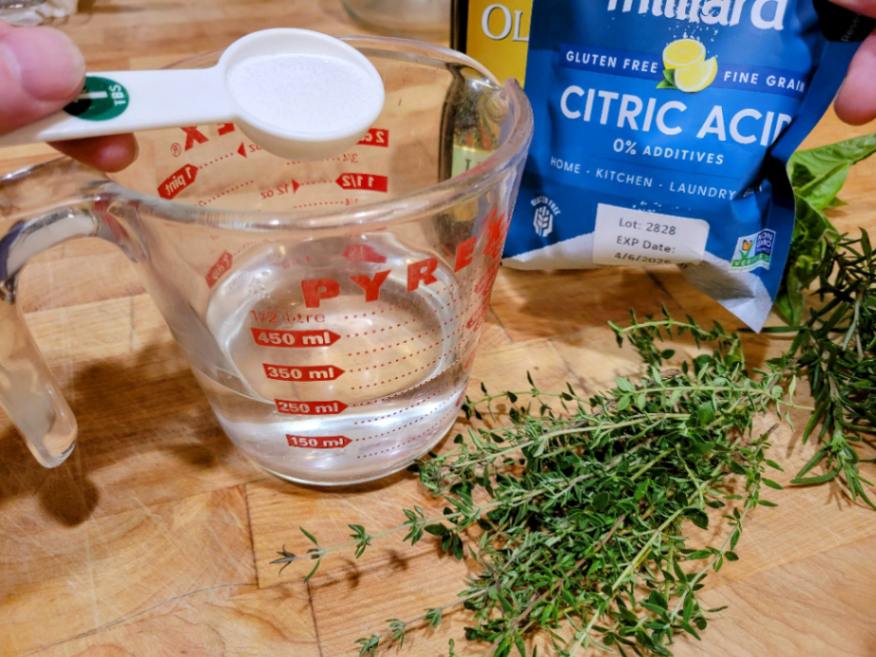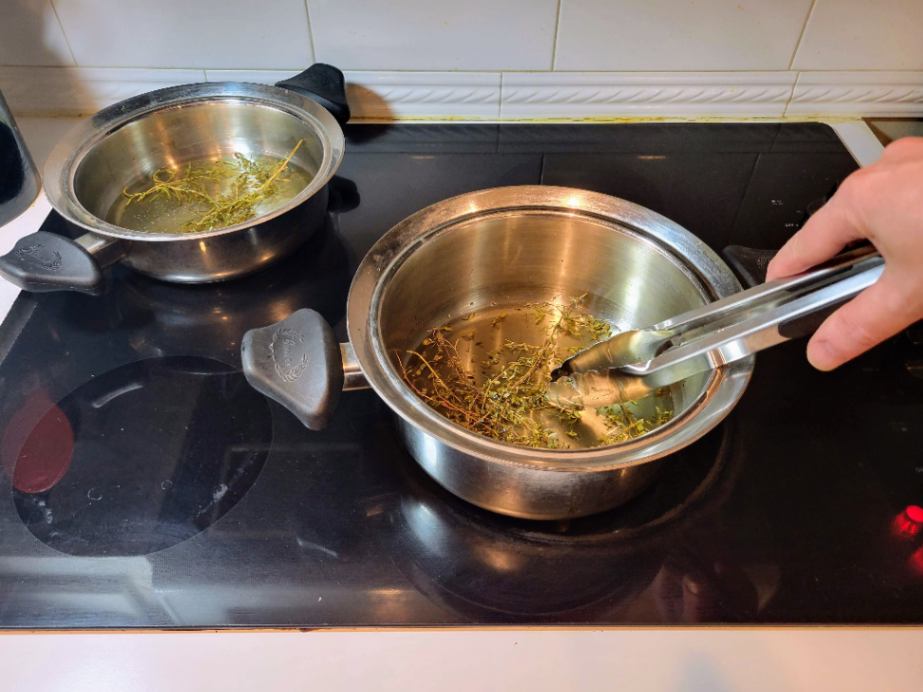This post may contain affiliate links which means I may receive a commission for purchases made through links. I only recommend products that I have personally used. As an Amazon Associate I earn from qualifying purchases. Learn more on my Private Policy page.
An underutilized method for preserving one’s herb garden harvest is to imbue their essence into cooking oils. There are a handful of culinary garden herbs that truly shine as ideal candidates when it comes to herb preservation through oil infusion.
The best herbs to infuse oils for culinary purposes are basil, rosemary, thyme, oregano, sage, tarragon and lavender. These herbs infuse their essence into cooking oils without difficulty and are widely employed in various culinary applications where oil is a suitable cooking ingredient.
Let’s take a closer look at why these 7 herbs are perfect candidates and discover the secrets to skillful oil infusion for your culinary endeavors.
Table of Contents
Best Herbs to Use for Infused Cooking Oils

1) Basil
Basil is one of the most common herbs to infuse in oils due to its fresh, slightly peppery taste which is easily imparted into cooking oils. Commonly used in Mediterranean and Italian cuisines, basil-infused oils can imbue basil’s taste and aroma into salad dressings, pasta salads, vegetable dishes, and sauces.

2) Rosemary
Rosemary, with its strong piney aroma, is another herb that is frequently used to infuse culinary oils. Rosemary-infused oils work well for enhancing the flavor of meats, particularly lamb and chicken. It is also an excellent oil to use for roasting vegetables.

3) Thyme
With its mild earthy taste and subtle undertones of mint, thyme-flavored oils work well to complement roasted vegetables and poultry. It is also often used in marinades and words great for sautéing vegetables and meats for soups and stews.

4) Oregano
Oregano has a robust, earthy flavor profile that lends itself well to classic Italian and Greek dishes. Oregano-infused oils are commonly used in marinades, for drizzling over salads and pasta dishes, and for roasting potatoes.

5) Sage
Sage, known for its slightly peppery flavor with hints of mint, is another versatile herb for infusing oils. Sage-infused oils complement meat dishes well, especially pork, and can add depth to pasta dishes, marinades, and sauces.

6) Tarragon
Tarragon has a distinctive flavor reminiscent of anise or licorice which easily imparts itself into culinary oils. Tarragon-infused oils are often used in chicken and fish-based dishes and bring a hint of exotic sweetness to your cooking creations.

7) Lavender
Lavender is known for its distinctly floral and slightly sweet flavor. Lavender-infused oils can offer a unique twist to both savory and sweet creations with this herb’s elegant taste that brings a touch of sophistication to your culinary endeavors.
Best Oils to Use for Herb-Infused Oils
Beyond knowing which herbs to use for oil infusions, it’s equally important to know the ideal oils to use.
While it is a common kitchen staple, extra virgin olive oil’s strong and distinct taste may not be the best match for herb-infused oils, as it has the potential to overwhelm the herbs’ fragrance and flavor profiles.
While many home cooks suggest opting for neutral-tasting oils like canola or vegetable oil for herb-infused creations, my personal preference leans toward lightly flavored olive oils. I find that a subtle olive oil note complements can complement herbs in infused oils, as long as it doesn’t overpower the herbs. By avoiding the robustness of extra virgin olive oil and choosing milder variants, I tend to get the results and flavor profiles I’m after.

As always, experiment to see what works best for you. I do recommend you avoid strong-tasting oils such as extra virgin olive oil, avocado oil, sesame oil, and other oils with a strong and distinct flavor or aroma.
How to Make Herb-Infused Oils for Cooking
Check out my YouTube video below to learn how to prepare culinary herb-infused oils.
To create herb-infused oils, follow these steps:
Prepare Your Herbs
Harvest the herbs you want to infuse. Try to choose clean herbs that don’t require washing and dust off any loose soil or any insects.
Dry Out Herbs Completely (Optional)
To materially extend the shelf-life of your herb-infused oils, you can choose to thoroughly dry out your herbs using standard drying methods, such as air drying, dehydrating, oven drying, or even using an air fryer.
Using thoroughly dried herbs in infused oils can extend the shelf-life of your infused oils from weeks to months. See our article on How to Dry Basil: 5 Different Ways to explore various herb drying methods.
Acidify Your Herbs
A University of Idaho study on the Acidification of Herbs in Infused Oils demonstrates the importance of acidifying herbs prior to oil infusion to reduce their pH level. Reducing the pH of your herbs significantly reduces the risk of contaminations such as botulism, a bacteria that produces dangerous toxins.
The correct method for acidifying your herbs involves immersing them in citric acid for 24 hours. Citric acid can be commonly found in powdered form and mixed with water.

To acidify your herbs:
- Place your herbs in a medium-sized glass bowl.
- Prepare a citric acid solution by mixing citric acid with water (in a ratio of 1 ½ Tbsp citric acid powder to one cup of water) and pour it over the herbs. Be careful not to touch the citric acid or get any on your clothing, as it can cause considerable irritation.
- Allow your herbs to soak at room temperature for 24 hours. This will inhibit bacterial growth by increasing acidity.
Sterilize Containers
Sterilize the glass containers in which you’ll be storing your infused oils by boiling the containers in water for at least 15 minutes.
Rinse and Dry Herbs After Acidification
Rinse off your herbs after they’ve been soaking in the acid bath for 24 hours. Also, make certain to let them dry out thoroughly before you begin the infusion process.
Introducing excess moisture into herb-infused oils is another factor that can potentially lead to the growth of bacteria like botulism, so take the time to make sure your herbs are dried out completely before infusing them.
Release Herb Oils
Extract the aromatic compounds of the herb by bruising it with a roller or mashing it with a mallet. Gently crushing your herb will help them to more fully infuse the oil with their herbal essence.
Infuse Herbs
Pour the oil you’ve selected for infusing into a pan on a stovetop and heat the oil to 140°F (60°C). Once the oil is up to temperature, place your herbs into the heated oil and let them infuse for 5 minutes. Don’t infuse your herb oil for longer than 5 minutes, as this could potentially cause negative results.

While some home cooks recommend infusing herb oils for a longer period of time at room temperature, according to the University of Idaho study referenced above, infusing herb oils at 140°F for just a few minutes produces better flavor and aroma for most herbs than the room temperature method.
Strain Herbs
For the best oil quality and to extend the shelf life of your oil, it’s best to remove the herbs from the oil before storage. If you’re planning to use your oil within a few days, however, it’s okay to skip this step.
To remove the herbs, simply pour the oil through a strainer into another container and discard the herbs.
Store Herb Infused Oil
Once your oil has cooled, store your herb-infused oil in airtight containers in the refrigerator. If you utilize completely dried herbs for infusion, you can store your herb-infused oil in an airtight container in a cool, dark place like a pantry.
How Long Do Herb-Infused Oils Last?
The shelf-life of herb-infused oils depends upon ingredients and infusion method. When refrigerated, oils infused with non-acidified fresh herbs will only last 2-3 days, but using acidified fresh herbs extends that up to 3 weeks. Oils infused with acidified dried herbs can last up to 3 months in a cool, dark place.
| Herb Type | Shelf Life |
|---|---|
| Fresh herbs (non-acidified) stored in refrigerator | 2-4 days1 |
| Fresh herbs (acidified) stored in refrigerator | 2-3 weeks2 |
| Dried herbs (acidified) stored in a cool, dark place | Up to 3 months2 |
Source:
- Zepp, Martha. “How to Safely Make Infused Oils.” PennState Extension, May 13, 2019, https://extension.psu.edu/how-to-safely-make-infused-oils
- Mars, Aimee. “Infused Oil Recipes.” AimeeMars.com, April 1, 2022, https://www.aimeemars.com/infused-olive-oil-recipes/
Last Updated on 13 October 2023 by Bob Lee

